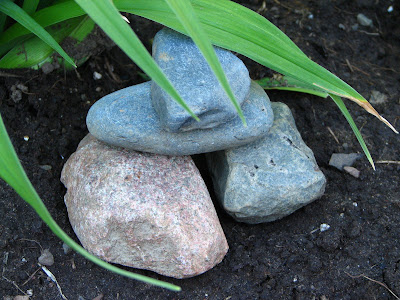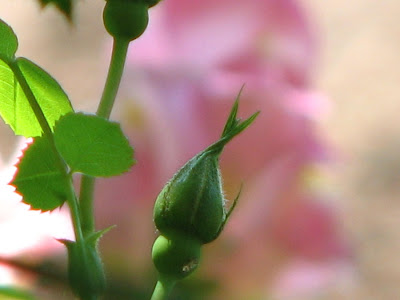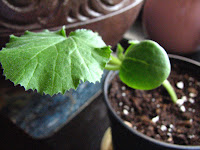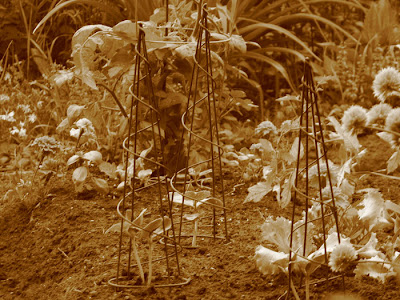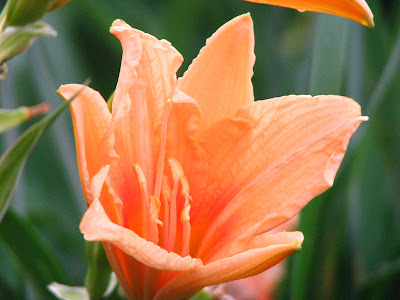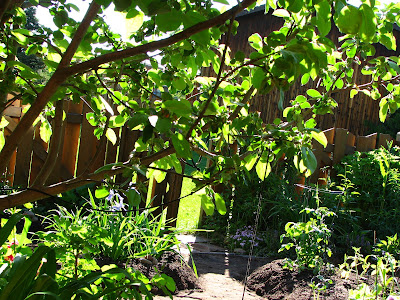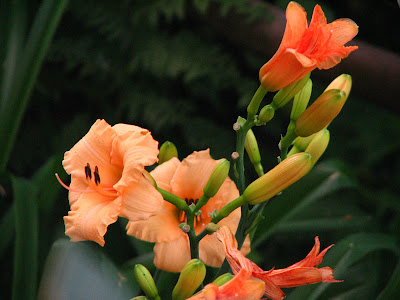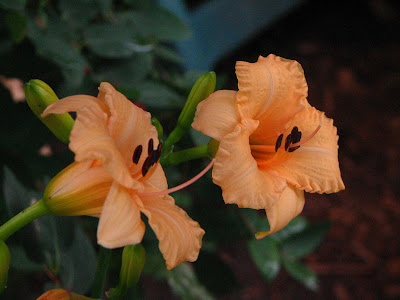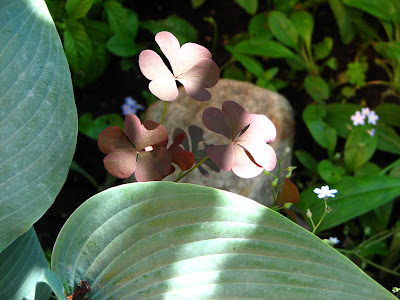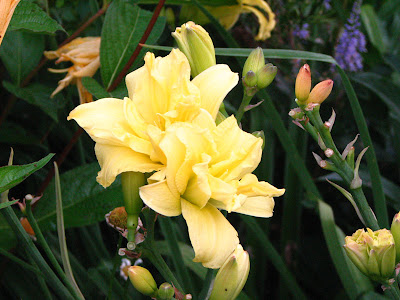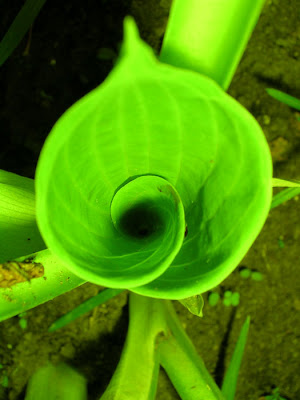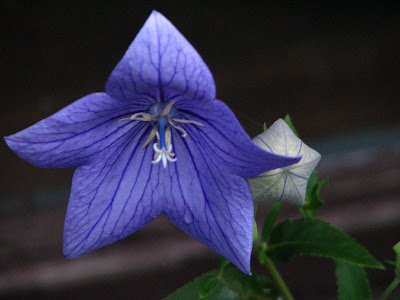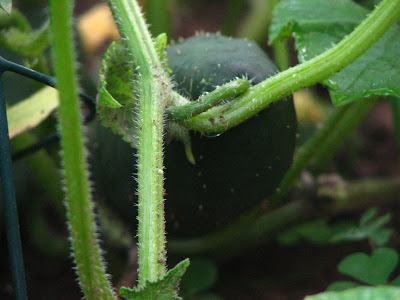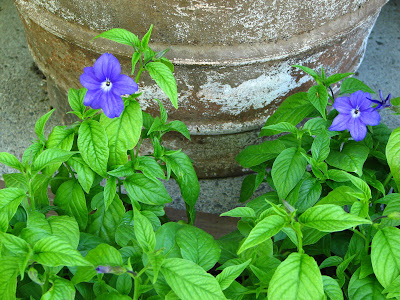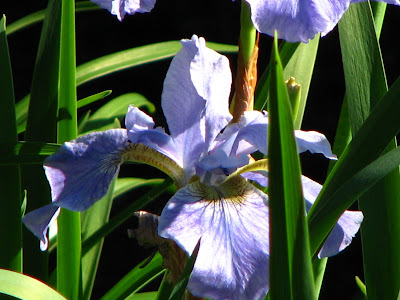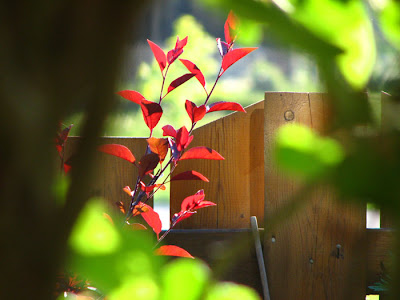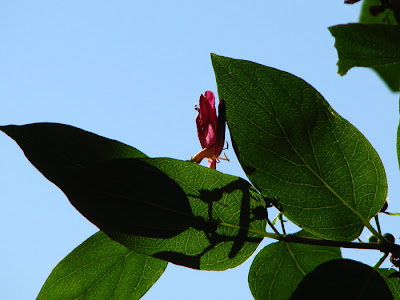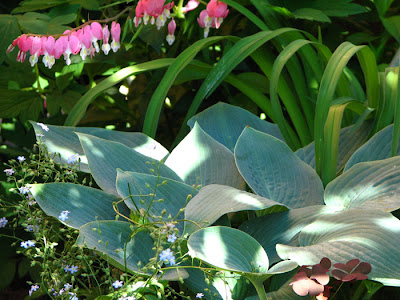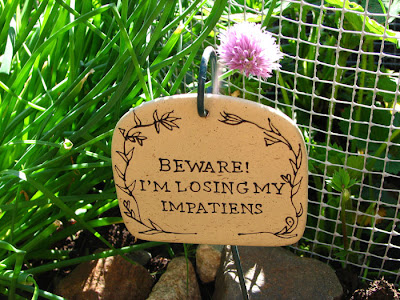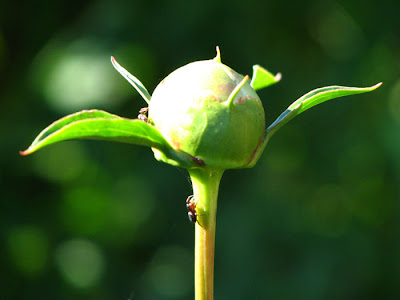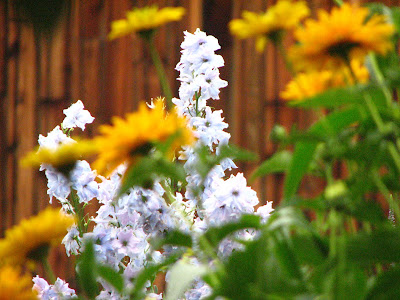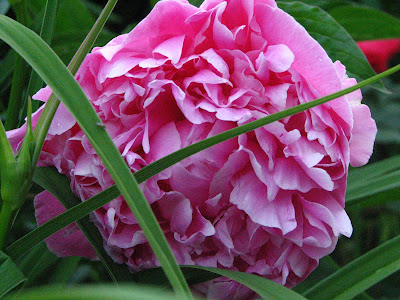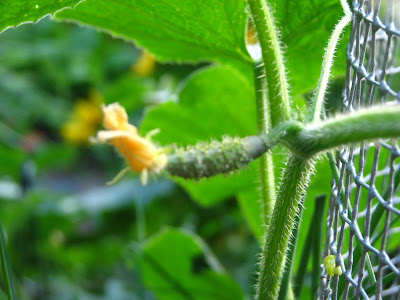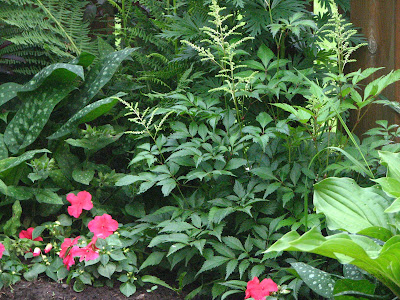Ajuga is a member of the mint family, and like most mints, its rapid growth rate may create problems. If this invasive attribute of Ajuga is a problem, it may be necessary to use some type of edging material to keep it within bounds.
Ajuga tolerates a wide range of soil conditions as long as soil is well drained. The soil pH should be somewhere within the range of 3.7 to 6.5. It may be grown in any type of light from full sun to full shade. The leaves will tend to be smaller when grown in full sun, but the plant will produce more flower spikes. Ajuga prefers moist soil, but will tolerate drought remarkably well.
Established plants should be set or transplanted in the garden in early spring. Plant them 12 to 15 inches apart, being careful not to plant too deeply. The crown should never be covered with soil or the plant will rot and die. Ajuga is propagated by division, which can be done in fall or spring. The runners are easily removed from the mother plant when they are young. Removal of these offsets will become more difficult as they age, because they will become entangled in the main plant. It is a good idea to remove these runners periodically anyway, even if they are to be discarded. This will help to keep the plant contained.
Pruning is done by either mowing or cutting the foliage back to the ground. About every third year, large, crowded groupings should be thinned out to reduce the chance of crown rot. As non variegated foliage appears on variegated forms of Ajuga, it should be removed. This will prevent the plant from reverting back to it's original green form.
(I did not write this, I don't know where it came from)
Saturday, March 31, 2007
Ajuga
Hannah, Rock Stacker
The North-West Corner


It changed regularly. I moved plants around probably more than I should have, but I was willing to risk mistakes because there's no better way to learn (trial and error). Sometimes plants behave differently than expected, and that's okay - I'm willing to accommodate.
I had a very small space, less than half that I do now. 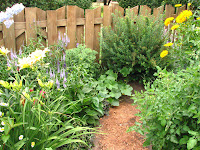 The north-west corner began as my primary "butterfly garden" but as some plants (ahem, Delphiniums, Speedwell) grew uncontrollable, billowing, and drooping all over the others, who, over the years changed faces from time to time until it became mob of representatives. Bugleweed (ajuga) smothered the creeping Plox but there were still plenty of prickly purple blooms last year to prove that Plox can't so easily be outed. I had (surprisingly) some Coreopsis (C. verticillata ‘Moonbeam’ ) that reappeared year after year, I know, I don't believe it either, but it was there, beaming out from within the thicket.
The north-west corner began as my primary "butterfly garden" but as some plants (ahem, Delphiniums, Speedwell) grew uncontrollable, billowing, and drooping all over the others, who, over the years changed faces from time to time until it became mob of representatives. Bugleweed (ajuga) smothered the creeping Plox but there were still plenty of prickly purple blooms last year to prove that Plox can't so easily be outed. I had (surprisingly) some Coreopsis (C. verticillata ‘Moonbeam’ ) that reappeared year after year, I know, I don't believe it either, but it was there, beaming out from within the thicket.
Rudbeckia became a smash hit last year  with a swarm of brown eyed blooms, that mixed so well with the Veronica. There were Daisies too, but they just came out of nowhere (from some planting at some time, but they had naturalized to the area, which pleased me muchly. I did nothing but thank them for coming). The painted Daisies were removed, and I don't think I'll try them again. They were spindly.
with a swarm of brown eyed blooms, that mixed so well with the Veronica. There were Daisies too, but they just came out of nowhere (from some planting at some time, but they had naturalized to the area, which pleased me muchly. I did nothing but thank them for coming). The painted Daisies were removed, and I don't think I'll try them again. They were spindly.
Those Delphiniums. What can I say - 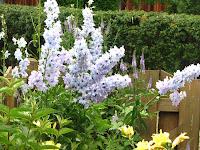 I love that plant, but groan at the thought of the maintenance. I'll plant them again in the new garden because I do like (love them) them and I can't imagine a cottage garden without them. I've never had great luck with Foxglove, but I will plant those again too. Lupins though, no....we'll leave those wolves in the woods, thanks. Too bad - they remind me of being young, in my jungle.
I love that plant, but groan at the thought of the maintenance. I'll plant them again in the new garden because I do like (love them) them and I can't imagine a cottage garden without them. I've never had great luck with Foxglove, but I will plant those again too. Lupins though, no....we'll leave those wolves in the woods, thanks. Too bad - they remind me of being young, in my jungle.
Hydrangea, yes - I need one of those. Which one will depend on what I can find. That Weigela made an incredible show the last few years, another one of those is on my list (the hummingbirds loved it). There were Butterfly Delphiniums in there too, and some white Jacob's Ladder, Tall Garden Pholx (pink) (but I think that got smothered by the speedwell). Heuchera Coral Bells, and some moonbeam Yarrow were also planted.
The rose was Winchester Cathedral (where my parents once watched the changing of the bells *how romantic*). It didn't survive last year, but it is the first rose on my list for the new beds. At the time of the picture here, I hadn't planted anything in that spot yet - so there's a gap. Winnipeg Parks was chosen and planted a little late in the season - I took it with me in the move so we'll just have to wait and see how it does. (it doesn't look dead) (it's in the bed by the porch now) Winchester was perfect in the northwest corner, I really loved that rose - blooms the size of softballs. I could smell them in Hannah's room.
Double River Wye is my favorite Daylily (most of the time,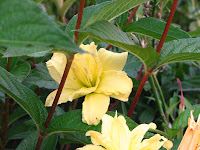 sometimes I have a hard time choosing a favorite). This one, -it's sooo pretty, the most delicious buttery-lemony yellow double blooms non-stop. (I noticed that Vanilla Fluff looks very similar, only it's color (of course) is vanilla.) Double River Wye became entangled the branches of the Weigela last year, squeezing blooms through all over the place.
sometimes I have a hard time choosing a favorite). This one, -it's sooo pretty, the most delicious buttery-lemony yellow double blooms non-stop. (I noticed that Vanilla Fluff looks very similar, only it's color (of course) is vanilla.) Double River Wye became entangled the branches of the Weigela last year, squeezing blooms through all over the place.
The snowmound Spirea looked quite 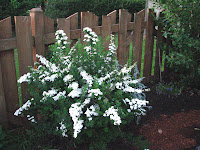 dramatic the evening I took these pictures. It was dark because of storm clouds, not the hour making the white really pop from the plant. Beside it used to be the old fashioned rose, Heritage, which year after year grew beautiful and strong but sadly, almost every bud suffered decapitation by chipmunk. Oh, I was so angry with those rodents! I will try Heritage again in the new beds. It's blooms are big like Winchester's, and I remember them being a peachy-rose-pink, a great color.
dramatic the evening I took these pictures. It was dark because of storm clouds, not the hour making the white really pop from the plant. Beside it used to be the old fashioned rose, Heritage, which year after year grew beautiful and strong but sadly, almost every bud suffered decapitation by chipmunk. Oh, I was so angry with those rodents! I will try Heritage again in the new beds. It's blooms are big like Winchester's, and I remember them being a peachy-rose-pink, a great color.
They sky that evening (when I took these dark photographs), after the storm, was amazing.
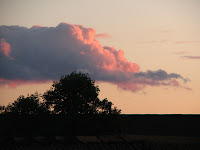
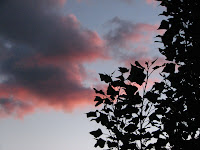

New House, New Garden
 I brought as many plants as I could, waiting until late September to move them. By that time, I was so exhausted by the move and the backwardness of my new home that I wasn't as orderly as I would have liked. That, combined with a winter of very little snow and variable temperatures, is making me feel more and more like I'm starting from scratch here.
I brought as many plants as I could, waiting until late September to move them. By that time, I was so exhausted by the move and the backwardness of my new home that I wasn't as orderly as I would have liked. That, combined with a winter of very little snow and variable temperatures, is making me feel more and more like I'm starting from scratch here.
Other than the lock stoned-in containers against the porch, nobody has ever done anything to this yard. It's virgin territory for my dirty, dirty hands and I can't help but feel titillated by that. It was one of the things that drew me to this house.
I feel experienced, as if my garden had been my testing ground, and this is the next step. This is where I put all that I learned over the years to good use and create something even more spectacular. I look at what I had done and know all the mistakes that turned out to be fabulous, and fabulous things that just don't belong - I can expand those boundaries, plant more (I have the space now) - I can recreate what I loved most, properly, with more space...and just let them thrive.
I adore cottage gardens, English gardens, roses and vegetables, herbs - all of it together. I love letting the plants do as they wish (within reason, of course, heh) and watch them explore as they grow (like that pumpkin plant who grew through my 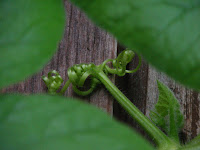 chair last year, the curly one haa that made me laugh....I wish I could have seen my garden through to the end without disruption last year, how sad I will always feel for that *sniff*) .
chair last year, the curly one haa that made me laugh....I wish I could have seen my garden through to the end without disruption last year, how sad I will always feel for that *sniff*) .
I also admire woodland gardens thick with native plants, I'm sure in thanks to all my years spent in Wishart. I like to think that in some teeming way, a cottage woodland English way, that is what I created. 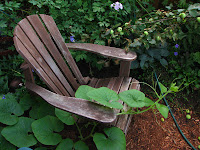 I'm going to recreate it, better though - and I'm going to erect a greenhouse, a small one just in front of the shed. A small greenhouse, just enough space for a few trays and pots, soil storage, away from cats, and wood floors, and cold front porches. I'd like to get something growing over and arbor-ish sort of construction between the two, maybe those Hops can latch on? Hmm. (the neighbors have hops that have hopped into our yard)
I'm going to recreate it, better though - and I'm going to erect a greenhouse, a small one just in front of the shed. A small greenhouse, just enough space for a few trays and pots, soil storage, away from cats, and wood floors, and cold front porches. I'd like to get something growing over and arbor-ish sort of construction between the two, maybe those Hops can latch on? Hmm. (the neighbors have hops that have hopped into our yard)
Wow, I am so excited to see the neighbor's Lilac grow and bloom which is going to be soon, yay! I hope they're the same color as my bike. (The neighbors to the west have an enormous Lilac that leans over into our yard - she explained when we moved in that she was terrified of new neighbors who might want her to cut it back, and how thankful she was when I told her I wished it was mine; we are both happy.) The Lilac has a "partner", a Virginia Creeper, who has crept up and over, dangling down into our yard. I was mesmerized by it in the fall, especially in the morning.
The back yard is 25' by 50' with a 8.5' by 10' foot shed in the northwest corner. There are huge 

 crab apple trees to our east, huge trees all around everywhere, with nests, an apple tree in the Lilac neighbors yard, cats (Annabelle and Maxine - that I know of so far), and kangaroo-like squirrels playing everywhere. We're bringing in a bat house, birdhouses, (squirrel-be-gone)bird feeders, and an entomological-ecological backyard experiment. Should be fun!
crab apple trees to our east, huge trees all around everywhere, with nests, an apple tree in the Lilac neighbors yard, cats (Annabelle and Maxine - that I know of so far), and kangaroo-like squirrels playing everywhere. We're bringing in a bat house, birdhouses, (squirrel-be-gone)bird feeders, and an entomological-ecological backyard experiment. Should be fun!
The house shades a good part of the yard - I'll be watching that more closely over the next months. I'm happy about that in many ways, because I've always wanted a big shade garden (I love hostas and ferns and the luxurious foliage displays that can be created). I suspect though that this will be a mostly potted shade garden, from what I have going on in my mind. Shh, for now...
The front yard has it's challenges: people walking through it (grr), garbage (damn litterers), and the neighbors truck. I'll make a barrier with treated 2" x 4" that with hopefully blend nicely into the bed to prevent the truck from rolling into the garden.
I'm only thinking about the one side, the south east corner. The other side of the walkway will hopefully become a small, tidy driveway, hopefully cement. I work around that when the time comes.
The side I will work with with be a lily bed, along with well planned waves of early, mid, and late blooming narcissi, daffodils, tulips, and crocuses. The Daylilies will take over for the early, mid, and late summer and, as usual, they will all mean something. When there're so many choices, I like  narrowing mine by planting those that relate in some way or anther, silly, thoughful, or nerdy to some part of my life. I like that my garden has so many stories.
narrowing mine by planting those that relate in some way or anther, silly, thoughful, or nerdy to some part of my life. I like that my garden has so many stories.
I'd like to put roses in the beds near the porch. It gets a lot of sun, and it's warm, protected, and I can take advantage of those deep beds when amending the soil and really do it right. In the with roses will be Lavender (which I will consider an annual until one year it surprises me, and returns), Rosemary, and maybe some Thyme. I'd also like to find two newer window boxes of the same design that I have already and have them hung off the porch windows. All my former window boxes have been in the shade, so this will be new - a sunny window box.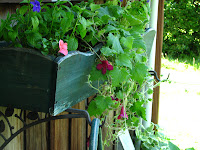 I can't stop thinking about the Lophospermum
I can't stop thinking about the Lophospermum  (Great cascade) in the window box last year - which claims to be a sun lover, but from my experience with it, it shrivelled in the sun, but seemed to thrive in the dappled morning sunny/ mostly shady place I had it. I'll probably try it again in this sunny spot, just to see what happens - the worse thing that could happen would be a sudden move to the backyard, which I wouldn't mind at all anyway.
(Great cascade) in the window box last year - which claims to be a sun lover, but from my experience with it, it shrivelled in the sun, but seemed to thrive in the dappled morning sunny/ mostly shady place I had it. I'll probably try it again in this sunny spot, just to see what happens - the worse thing that could happen would be a sudden move to the backyard, which I wouldn't mind at all anyway. There's also a spectacular young Maple to the west of the yard, which I love but worry about whether there's going to be enough room for it as it grows. I intend to stay out of it's way, I hope it cooperates.
There's also a spectacular young Maple to the west of the yard, which I love but worry about whether there's going to be enough room for it as it grows. I intend to stay out of it's way, I hope it cooperates.
Friday, March 30, 2007
Wishart, my heart
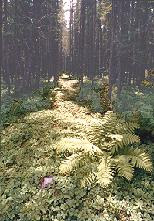
When I was a little girl I climbed a lot of trees. Our house was surrounded by a boreal jungle, and I considered it mine.
Wishart Conservation Forest, seen here in a picture borrowed from the Lakehead Region Conservation Authority, is exactly what I picture in my mind - that image - when I recall my earliest walks there with my father absorbing all he had to say about the plants, the trees, and blooms near our feet. He was an early riser, I think he's the reason I am, and I think that's why so many of my memories of Wishart are morning memories. Chickadees made the trees sing.
Wishart Conservation Forest was adjacent to the property line belonging to my parents. It was my father who wanted to own "everything he could see" - to avoid bad neighbours, of course (hah!). And that he did, but more importantly he sought serenity, away from everything. Eventually development caught up with him, although not directly; I can recall two events.
The first was the construction of a tower, some sort of television broadcasting transmitter, which disrupted the tree line along the hilltop horizon seen from our backyard. It was miles and miles away, across the Current River, through the forest, up over the hill. I think for a while he sought it, in his jeep - with myself along, sometimes my sister, driving the country roads around those hills between the river and Copenhagen Road. I'm sure he found it, but thankfully that memory isn't significant enough to recall. What my memories do recall are all the comments exchanged about how that tower changed that tree line, and how what was once not seen, now was.
The second is more distinct. It provoked me to identify with the trees, filling me with a protective appreciation for them. It was when the same tree line changed again after construction began on the other side of the hill. They started removing trees, White Pines, if you can believe it... it was those White Pines that made the tree line a tree line, without them it was a tree-top line.
There were three huge trees in the tear drop of our driveway, two Tamaracks and a Blue Spruce - huge. I climbed the Tamarack closest to the house most often; it had a great spread of branches, easy to navigate, (even in a dress) (I gave my mother heart attacks, she says). But, it was in these trees surrounded by that forest, I believe, that my interest in the natural world was founded.
I wandered away, through those woods for hours on end. The way I saw it, there was no way I could get lost (which was the worst thing I thought could happen, I guess bears didn't cross my mind then the way they do now *shrug*). I could wander south and bump into the Paquette dam ruins (that was one boundary I created), east I would hit the river. There I would stop to watch the beavers on a chunk of the dam ruins that was a few rock hops and two slightly wet boots into the river. I'd sit there quietly, often with Sam [DOG WHO WAS A WONDERFUL FRIEND] , and I'd sit there for long times sometimes waiting to see the flop of a beaver tail, and while I did I watched the trees and tried to remember things my parents told me about which one was which and how I could distinguish each better. For just as long I would watch them and think nothing but how beautiful they were, and I'd listen. Thankfully, I still make sure I do that.
West to the river was the road, and squaring off my boundary is the path through Wishart from the road to the river. Our house was near the middle-south of this rectangular playground. I'd be really curious to learn the footage of that plot I plotted. I can't remember a time in my life that I didn't wander around in there regularly, which only means that I've done that from my earliest memories which I'm beholden to (I make a point to think of it all, often, so as to not forget - ever).
I have these weird little snippets of mornings in Wishart with my father, looking at moss, or a Trillium, the forest floor. Bark was another thing he talked about, inadvertently-purposely creating files in my brain - if only he could know how I've been enjoying all his effort - and I recall on that when I try to tell one tree from another. I could wander through those trees, zig-zagging and going east to west in a web of directions, I saw so many. I think part of the reason I felt so safe was thanks to Sam, who ran in circles around me as I explored. He did that in the winter too, when I show shoed from my front door through to the entrance of something people drove to for what seemed forever.... to a place that was mine. I always wondered how many other people felt it was theirs and always hoped many people do in whatever way they imagined (as I had), and I'd watch them admiring the trees, and the sun shining through the trees, and I'd smile to myself because I felt so lucky to live there.
There was a creek just beyond the decrepit barn between our house and the forest between us and Wishart, I crossed it often. The ferns were thick, spotting fiddle heads was a game we played on muddy walks in April.
Because my memory isn't as snazzy as my camera, I will make a vow now to document as much as I can remember this year. I the process, I hope Hannah inadvertently-purposely creates a few files of her own in the process. I hope she listens to Natalie McMaster's fiddle while she does that too, because the music really suits the subject (I'm listening now and I like it).
I couldn't imagine living there now and functioning in my life properly, which only makes me admire it more and be thankful for it. I had memorized the trees, the topography, the relations - I knew that forest and I believe it defines a great part of what I admire, keep trying to recreate in some way or another. I will again.
I'm going to teach Hannah the art of climbing trees in a dress this summer. Heh.
University of Guelph stuff (and some books)
http://www.horticulturecertificates.com/
University of Guelph Library resources:
www.lib.uoguelph.ca/facilities/offcampus.cfmwww
http://www.lib.uoguelph.ca/help/guides/index.cfm?code=hort
some books I want:
The Meaning of Gardens (Francis & Hester)
The MIT Press; New Ed edition (8 April 1992)
978-0262560610
The Oxford Companion to Gardens (Goode & Lancaster)
Oxford University Press; New Ed edition (30 Sep 2001)
978-0198604402
Recommended by and loaned to me from Cindy (thank you) - I really love this book!
The Language of Flowers (ed. Sheila Pickles)
Harmony Books, Crown Punlishers, Inc.
0-517-57460-8
Science and the Garden: The Scientific Basis of Horticultural Practice (David Ingram)
Blackwell Science Ltd (30 Jul 2002)
978-0632053087
Thursday, March 29, 2007
Dorothy and Daffodils (but not Wordsworthian)
Shakespeare, in The Winter's Tale, speaks of "Daffodils that come before the swallows dare and take the winds of March with beauty."
[DAFFODIL] (Wachsberger & James), arrived for me today and within the first four lines, a Shakespeare quote!
...before I go any further I have to post a link to the Norana Earth Sciences Library at U of T or I will forget...
The book goes on to bring up names like Theophrastus, Alexander Neckham, and William Turner, turning into a page turner itself...it's had me thinking about taxonomies all the way home, which got me thinking about more courses to take (the first begins May 14th) Soil Composition and Plant Growth? I believe is the name - The Dirt on Dirt I call it, either makes me grin. I hope that by applying this gardenerding under some guidance might give me direction - I feel like I've got so much garbled information in my head and that if I could get it all into some coherent order I just might soar ;)
..then trip over my flip flops in the GH. Heh.
That's been on my mind, the greenhouse. Dorothy dies last week, her service was on Wednesday and I sort of wish I had gone, and I wish I could say something to her family. Feverfew is what I connect with Dorothy but really she talked to me about many flowers, and some weeds, and I remember her for thinking the same as I - that they were as pretty as any flower....she was so sweet. She was one of my favorites, and I'm going to think of her often on River Street this year.
I wonder about the man from Silver Islet - I didn't see him last year, but then I wasn't around the greenhouse nearly as much, it's more hopeful to think I just missed him. He always has a list, handwritten by his wife, of geraniums of specific colors, assorted pansies, marigolds and petunias and he loads flat after flat into the back of his truck while telling the most incredible story - all of which I heard over two seasons and several visits at the River Street greenhouse. He talks about gardening, and Silver Islet, and his experiences both there and on this side of the Giant with the soil, the weather, the climate, and the plants, people, his wife, their garden(s)...and I hope he knows how grateful I am to have privy to all that he has confided.
It's people like that, with their tales, that changes the greenhouse from being an ordinary laborious retail job...it's so much more. People and plants are drawn together for so many reasons and I've been soaking up these reasons for years without an outlet - damn me for not having been writing this long ago.
There was a man, a few years ago, who bought daisies. He told me as he chose them that he planted daises every year at his daughter's grave, they were her favorite. She died when she was 16. He had to have been in his late seventies, maybe eighties - and I thought at the time, as I do now about how I can recognize that he has been doing this for many years, many years without his daughter, and that is such a hurtful thought - but he was smiling at those daisies, and he was smiling at me, and that is what flowers do for people, which is such a significant reason for me enjoying my days at that greenhouse. I've never been able to look at a daisy since and not think of that girl and her father.
Somebody at work today smirked to me at the title of a book on the subject of plants of Middle Earth because there is just so much stuff on stuff and everything is written about. I was too embarrassed to admit that I had jotted down that title when I went through those slips earlier. I write down lots of titles though, so don't take anything seriously until you see me order it (I still have five more on the way) :P
Literature and people, people and flowers, people and their stories about their flowers, I'm really curious about it all.
I'm going to miss seeing Dorothy.
Clematis reminder
The best time to prune clematis depends on the type...
Prune early-flowering types by July, large-flowering types to the top set of green buds in March, and cut back late bloomers to 3 feet tall while dormant.









